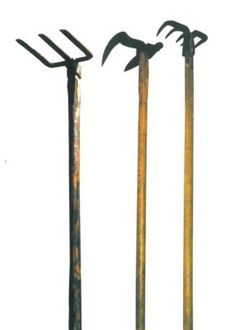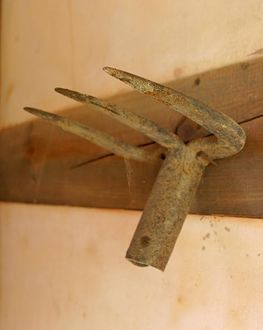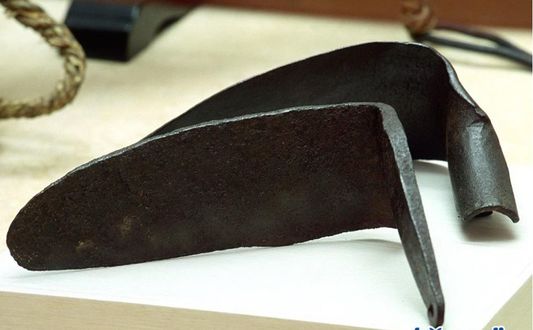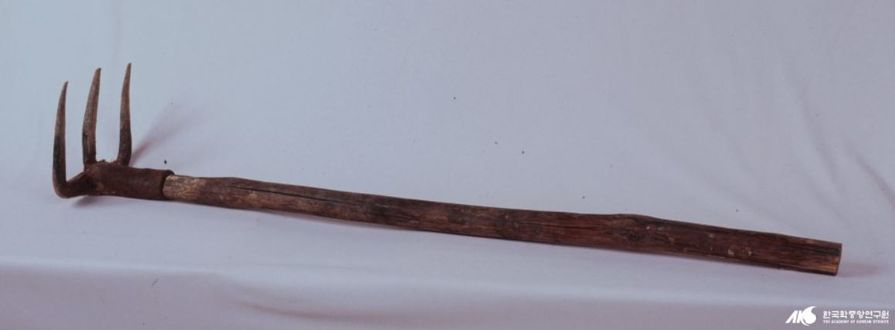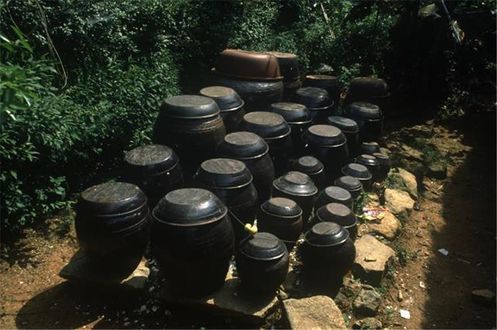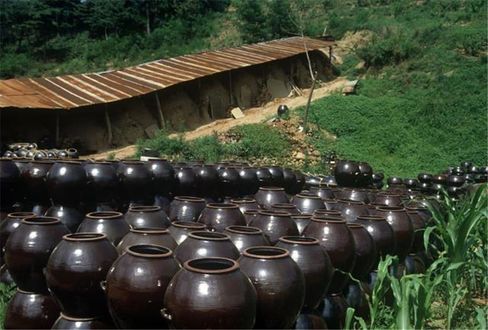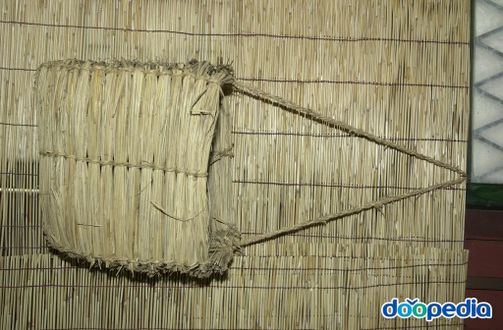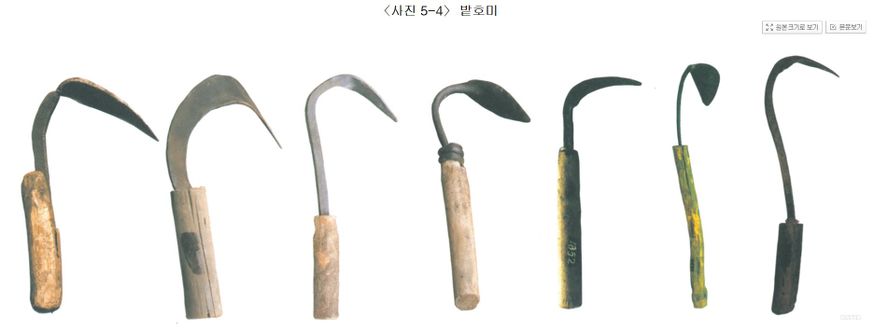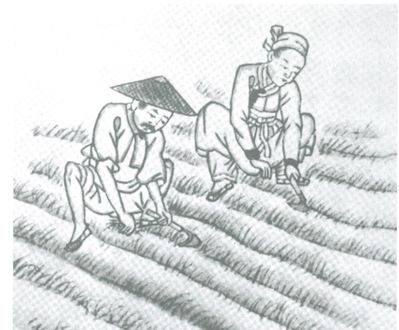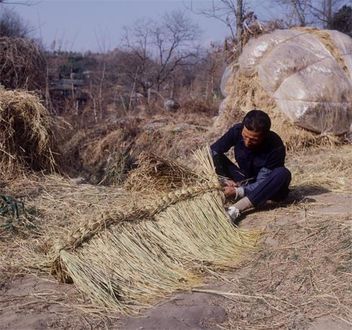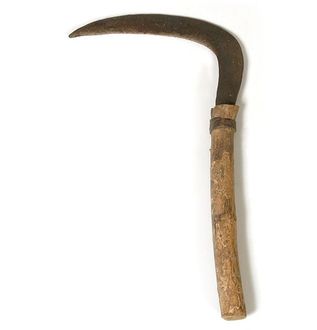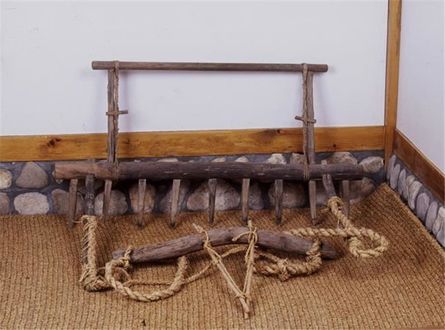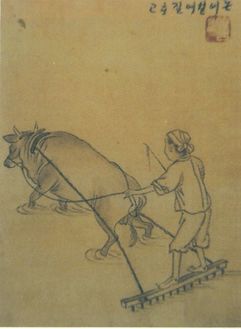"NJ2018 Glossary - Farming Tools"의 두 판 사이의 차이
(→Earthenware jar) |
(→Grass (Straw)) |
||
| 159번째 줄: | 159번째 줄: | ||
}} | }} | ||
'''Explanation'''<br/> | '''Explanation'''<br/> | ||
| − | + | Used for preparing the soil for cultivation.<br/> | |
| − | + | In the chapter about [http://dh.aks.ac.kr/~classics/wiki/index.php/NJ2018_Plowing_the_Soil Plowing the Soil] it is translated both as ''straw'' and ''grass''.<br/> | |
| − | + | Passages from the text:<br/> | |
| − | + | *'For dry fields, straw should be spread and burned after the first plowing.' <br/> | |
| − | * | + | *'For uncultivated land, plow between seventh and eighth (lunar) months and cover the land with grass.'<br/> |
==Hemp sacks== | ==Hemp sacks== | ||
2018년 6월 14일 (목) 19:21 판
| Nongsa jikseol | |
|---|---|
| Table of Contents | |
![]() Contributor: Ciceo Anca Valentina
Contributor: Ciceo Anca Valentina
목차
- 1 Aged manure
- 2 Bunhoe
- 3 Cheolchipa
- 4 Chopped Weeds
- 5 Earthenware jar
- 6 Grass (Straw)
- 7 Hemp sacks
- 8 Hocheon
- 9 Homi
- 10 Jeomcheon
- 11 Large scythe with a long handle
- 12 Manure (cow and horse manure)
- 13 Mixture of urine and ash
- 14 Mokjak
- 15 Mokjakbae
- 16 Mussle
- 17 Night soil
- 18 Noemok
- 19 Oak stems with leaves
- 20 Ox
- 21 Pallo
- 22 Paro
- 23 Pool
- 24 Ro
- 25 Silkworm droppings
- 26 Stable (cow and horse stable)
- 27 Stalks
- 28 Storage pit
- 29 Straw mat
- 30 Urine
- 31 Wooden tub (trough)
Aged manure
| Basic Info | |||
| • Hanja: 熟糞 | • Hangeul: 숙분 | • RR: Sukbun | • MR: Sukpun |
Explanation
- 熟: ripe; cooked; done; skilled; familiar; familar; familiar with; well-cooked[AM 1]
- Bunhoe is an abbreviation for mix of aged manure and urinated ash.[AM 2]
Bunhoe
| Basic Info | |||
| • Hanja: 糞灰 | • Hangeul: 분회 | • RR: Bunhoe | • MR: Punhoe |
Definition
인분뇨와 재를 섞어 만든 자급비료로 악취가 없으며 병균과 해충의 번식을 막고 외관상 흉하지 않다.옛날부터 사용하였다. 분회는 인분뇨의 악취를 제거하고 강알칼리성이어서 병균과 해충의 번식을 막을 수 있고 외관상 흉하지 않으며 고형이어서 취급에 편리한 점이 있다. 인분뇨 중의 암모니아상태의 질소가 재 속의 알칼리와 반응하여 휘산되는 단점이 있다.[Bh 1]
Bunhoe is an abbreviation for mix of aged manure and urinated ash.[Bh 2]
See the glossary entries for 'aged manure' and 'mixture of urine and ash'.
Further Reading
- Stored Human Urine Supplemented with Wood Ash as Fertilizer in Tomato (Solanum lycopersicum) Cultivation and Its Impacts on Fruit Yield and Quality
- Human Pee With Ash Is a Natural Fertilizer, Study Says
- 네이버지식백과:한국의 생활사
- More information on the use of fertilizers in Joseon, 杼葉 갈잎 and 牛馬糞 우마분[http://www.aghistory.or.kr/pdf/%EB%86%8D%EC%97%85%EC%82%AC%EC%97%B0%EA%B5%AC7-1-2.pdf 조선시대의 시비기술(施肥技術)과
분뇨(糞尿)이용],![]() Contributor: Evelyn Ruiz
Contributor: Evelyn Ruiz
Cheolchipa
| Basic Info | |||
| • Hanja: 鐵齒擺 | • Hangeul: 철치파 | • RR: Cheolchipa | • MR: Ch'ŏlch'ip'a |
| Common Name | |||
| • Hanja: 手愁音 | • Hangeul: 수수음 | • RR: Susueum | • MR: Susuŭm |
| Alternate English Terms | |||
| • iron-toothed spreader, hoe | |||
Definition
땅을 파헤쳐 고르거나 두엄·풀무덤 등을 쳐내는 데 쓰는 농기구. 명칭은 지역에 따라 ‘소시랑(인천광역시 덕적도, 전라남도 보성·영광, 전라북도 일대)·소스랑(경상남도 영산)·쇠시랑(전라북도, 경상남도, 강원도 강릉)·소스랭이(평안남도)·쇠서랑’ 등으로도 불린다.『농사직설』에는 ‘철치파(鐵齒擺)주 01)’로 표기되어 있고 하위지(河緯地)의 유서(遺書)에는 ‘소시랑(小時郎)’으로, 『고사신서(攷事新書)』 농포문(農圃門)에는 ‘소시랑(小屎郎)’, 『해동농서』에는 ‘철탑(鐵塔)’으로 올라 있다.[Ch 1]
Explanation
A leveling tool.
Multimedia
- Video: 네이버
Chopped Weeds
| Basic Info | |||
| • Hanja: 雜草 | • Hangeul: 잡초 | • RR: Japcho | • MR: Chapch'o |
Explanation
Chopped weeds can be used as a fertilizer on barren fields.
Context-the English translation says:
'Alternatively, first spread chopped weeds between the ridges prior to plowing and sowing.'[CW 1]
Further Reading
Earthenware jar
| Basic Info | |||
| • Hanja: 瓮 | • Hangeul: 옹 | • RR: Ong | • MR: Ong |
Definition
한국에서는 대부분 저장 용기로 쓰인 기구이다. 일반 저장 용기와는 다르게 배가 불뚝 튀어나와 있으며 주로 곡물 간장이나 된장을 비롯한 조미료, 술 따위를 저장하는 용도이다. 곡물이 담긴 독은 헛간이나 곳간에 두고 조미료가 담긴 독은 집안에서도 햇볕이 잘 쪼이는 양지바른 곳에 돌로 낮은 단을 쌓아 장독대를 만들어 그곳에 모아둔다.[EJ 1]
Explanation
A passage from the original text, '冬月, 以瓮或槽埋地中, 要令不凍。', explains how to keep seeds in an earthenware jar or a wooden tub so they do not freeze in winter.
Multimedia
Further Reading
- ↑ 한국민족문화대백과사전:독,
 Contributor: 이창섭
Contributor: 이창섭
Grass (Straw)
| Basic Info | |||
| • Hanja: 草 | • Hangeul: 초 | • RR: Cho | • MR: Ch'o |
| Alternate English Terms | |||
| • straw, weed | |||
Explanation
Used for preparing the soil for cultivation.
In the chapter about Plowing the Soil it is translated both as straw and grass.
Passages from the text:
- 'For dry fields, straw should be spread and burned after the first plowing.'
- 'For uncultivated land, plow between seventh and eighth (lunar) months and cover the land with grass.'
Hemp sacks
| Basic Info | |||
| • Hanja: 布 | • Hangeul: 포 | • RR: Po | • MR: P'o |
Definition
베 주머니
포.<베포. 포자이다. 또 하포라고도 한다.[HS 1]
Explanation
The context, from the chapter about Preparing the Seed Grain:
以九穀種各一升各盛布襄, 埋於土宇中。
Seeds were put in hemp sacks then burried inside a storage pit to sprout.
Hocheon
| Basic Info | |||
| • Hanja: 蒿篅 | • Hangeul: 호천 | • RR: Hocheon | • MR: Hoch'ŏn |
| Common Name | |||
| • Hanja: 空石 | • Hangeul: 빈섬/공섬 | • RR: Binseom/Gongseom | • MR: Pinsŏm/Kongsŏm |
| Alternate English Terms | |||
| • Bowl made by Straw (look for correct term in English) | |||
Definition
곡물이나 사료 등을 갈무리하는 데에 쓰는 짚으로 된 그릇. 섬은 ‘擔, 섬’(농정촬요), ‘空石’(산림경제), ‘俵, 셤’(月餘農歌), ‘蒿篅, 호천’(농사직설) 등으로 표기되었다. 가마니틀이 나오기 전에는 이것을 사용하였다. 모양은 가마니처럼 생겼으나 짚을 거칠게 쳐서 양끝을 안으로 우겨 넣고 꿰매었다. 섬의 크기는 날의 수로 따지는데 보통 다섯날섬과 일곱날섬이 많이 쓰이며, 일곱날섬에는 서른 말의 곡식을 담을 수 있다.[Ho 1]
Explanation
In the chapter about Cultivating Rice
it is translated as gongseom.
In 農事直說 it appears as 蒿篅, 호천, but it has various names in different texts: ‘擔, 섬 (農政撮要,농정촬요), ‘空石, 공석’ (山林經濟,산림경제), ‘俵, 셤’(月餘農歌,월여농가). Nowadays it is called 섬 in Korean.[Ho 2]
Multimedia
Homi
| Basic Info | |||
| • Hanja: 鋤 | • Hangeul: 호미 | • RR: Homi | • MR: Homi |
| Alternate English Terms | |||
| • hoe | |||
Definition
논밭의 김을 매거나 주로 사용하는 한국고유의 연장이다. 우리 호미는 서유구(徐有榘, 1764∼1827)의 『임원경제지』에서도 동서(東鋤, 동쪽나라의 호미)라고 했을 만큼 우리나라에서나 볼 수 있는 연장이었다. 부등변 삼각형인 날의 한쪽 모서리에 목을 이어대고 거기에 자루를 박은 독특한 형태의 연장인 호미는 이미 통일신라시대의 안압지 출토유물에서 확인할 수 있으며(제1편, 호미〈사진 24-3〉), 고려시대의 호미〈사진 5-1〉도 오늘날의 호미와 꼭 같다.[HM 1]
Explanation
鋤 is sometimes used as a verb and sometimes as a noun in the original text.
Multimedia
Further Reading
- 한국의 농기구, 2001. 6. 25., 어문각
Jeomcheon
| Basic Info | |||
| • Hanja: 苫薦 | • Hangeul: 점천 | • RR: Jeomcheon | • MR: Chŏmch'ŏn |
| Common Name | |||
| • Hanja: 飛介 | • Hangeul: 날개 | • RR: Nalgae | • MR: Nalgae |
| Alternate English Terms | |||
| • straw thatch | |||
Definition
이 단어는 이엉을 말한다. 이엉은 짚·풀잎·새 등으로 엮어 만든 지붕재료 또는 그 지붕을 지칭하기도 한다. 여기서는 동일한 재료로 씨앗이 겨울에 얼지 않도록 덮는 용도로 쓰였다.[Je 1]
Multimedia
Further Reading
- ↑
 Contributor: 이창섭
, see Preparing the Seed Grain
Contributor: 이창섭
, see Preparing the Seed Grain
Large scythe with a long handle
| Basic Info | |||
| • Hanja: 長柄大鎌 | • Hangeul: 긴 손잡이의 큰 낫 | ||
Definition
겸 (鎌): 낫. 풀•나무•곡식들을 베는 데 쓰는 농기구. 겸도(鎌刀).[SCY 1]
Used to cut the weeds.
Multimedia
Manure (cow and horse manure)
| Basic Info | |||
| • Hanja: 糞 (牛馬糞) | • Hangeul: 분 (우마분) | • RR: Bun (Umabun) | • MR: Pun (Umapun) |
| Alternate English Terms | |||
| • cattle and horse manure | |||
Definition
소나 말의 똥
Explanation
Used as fertiliser.
Mixture of urine and ash
| Basic Info | |||
| • Hanja: 尿灰 | • Hangeul: 요회 | • RR: Yohoe | • MR: Yohoe |
| Alternate English Terms | |||
| • urinated ash, urine and ash fertilizer | |||
Explanation
From the original, English version: 'Urine and ash fertilizer making method: Dig a small pool outside the cow stable to store urine. Burn stalks, bran, chaff and the like into ashes, and mix it with the urine from the pool).'
Further Reading
- Stored Human Urine Supplemented with Wood Ash as Fertilizer in Tomato (Solanum lycopersicum) Cultivation and Its Impacts on Fruit Yield and Quality
- Human Pee With Ash Is a Natural Fertilizer, Study Says
Mokjak
| Basic Info | |||
| • Hanja: 木斫 | • Hangeul: 목작 | • RR: Mokjak | • MR: Mokchak |
| Common Name | |||
| • Hanja: 所訖羅 | • Hangeul: 소흘라 | • RR: Soheulla | • MR: Sohŭlla |
| Alternate English Terms | |||
| • wooden harrow | |||
Definition
갈아 놓은 논이나 밭의 흙덩이를 바수거나 바닥을 판판하게 고르는 데 쓰는 농기구. ‘쓰래(경기도 덕적)·써리(경상남도 영산)·써으리(전라남도 영광)·써그레(강원도 도계)·성으리’라고도 하며, 『농사직설』에는 목작(木斫)으로 표기되어 있다.[Mo 1] 논에서는 쟁기로 간 논을 모내기 전에 물을 대고 써레로 쟁깃밥을 부수고 평평하게 고르는데 이를 ‘써레질’이라 한다. 그런데 예전에는 손잡이와 나루채를 빼고 써레 몸통에 봇줄만 매어 사람이 써레에 올라타고 써레질을 하기도 하였다〈그림 2-4〉. 소 한 마리로 하루에 2,000여 평의 논을 썰 수 있었다.[Mo 2]
Multimedia
Mokjakbae
| Basic Info | |||
| • Hanja: 木斫背 | • Hangeul: 목작배 | • RR: Mokjakbae | • MR: Mokchakpae |
Explanation
- 농사직설에 나타난 농기구는 모두 10종으로, 이에는 따비·쟁기·쇠스랑·써레·끌개[撈]·번지·고무래·곰방메·끌개[縳柴木兩參個]·끌개[木斫背]·끌개[輪木]·오줌구유·호미·낫·도리깨·키·날개·거적·섬·되·말·석·부리망 등 23가지가 포함된다. 이 가운데 땅을 삶는 연장의 종류와 수량은 압도적으로 많아서 39%에 이른다. 더구나 쇠스랑과 써레가 네 번, 번지와 곰방메가 두 번씩 등장하고 끌개도 4종이나 쓰여진 것으로 미루어, 당시에는 흙덩이를 고루 부수는 일에 큰 관심을 기울였음을 알 수 있다. 이러한 사정은 당시의 농업기술과 관련이 깊은 것이다.[MB 1]
- See the 'Cultivaning Barley and Wheat' chapter:
- 'After sowing is complete, use a cheolchipa (Its common name is susueum) or a mokchakpae (Its common name is soheullabae) to deeply cover the seeds.
- 'After sowing is complete, use a cheolchipa (Its common name is susueum) or a mokchakpae (Its common name is soheullabae) to deeply cover the seeds.
Further Reading
- ↑ 한국민족문화대백과:농기구,
 Contributor: 권지은 (source)
Contributor: 권지은 (source)
Mussle
| Basic Info | |||
| • Hanja: 網 | • Hangeul: 망 | • RR: Mang | • MR: Mang |
Definition
그물망. Used to cover the mouth of the ox when plowing.
Night soil
| Basic Info | |||
| • Hanja: 人糞 | • Hangeul: 인분 | • RR: Inbun | • MR: Inpun |
| Alternate English Terms | |||
| • human manure, human fertilizer, human waste, humanure | |||
Definition
Night soil is a euphemism for human feces collected from cesspools, privies, pail closets, pit latrines, privy middens, septic tanks, etc. Human excreta may be attractive as fertilizer because of the high demand for fertilizer and the relative availability of the material to create night soil. In areas where native soil is of poor quality, the local population may weigh the risk of using night soil.
Some people refer to human excreta as human manure, and the word "humanure" has also been used. Just like animal manure, it can be applied as a soil conditioner (reuse of excreta in agriculture). Sewage sludge is a material that contains human excreta, as it is generated after mixing excreta with water and treatment of the wastewater in a sewage treatment plant.[NS 1]
Since ancient times, the people of East Asia have traditionally supported a large population by utilizing this natural means of fertilization.[NS 2]
Multimedia
Extract available for preview online Science and Civilisation in China By Joseph Needham. Google Books Preview,![]() Contributor: Evelyn Ruiz
Contributor: Evelyn Ruiz
Further Reading
- Human faeces as a resource in agriculture
- Human waste use in agriculture and aquaculture
- Chinese tradition of utilizing human excreta
Related Article
- ↑ "Manure", Wikipedia.
- ↑ The Changing History of East Asian Human Manure Fertilization, Sustainability & Environmental Justice.
Noemok
| Basic Info | |||
| • Hanja: 檑木 | • Hangeul: 뇌목 | • RR: Noemok | • MR: Noemok |
| Common Name | |||
| • Hanja: 古音波 | • Hangeul: 고음파 | • RR: Go Eumpa | • MR: Ko Ŭmp'a |
Definition
흙덩이를 깨뜨리거나 골을 다듬으며, 씨뿌린 뒤 흙을 고르는 데 쓰는 연장. 1429년(세종 11)에 편찬한 『농사직설(農事直說)』에는 ‘유목(橊木)’으로 기록되어 있다. 지역에 따라서는 ‘통곰배(충청북도 제천시 봉양읍)·뭉퉁곰배(경상남도 창녕)·곰뱅이(전라남도 보성·고흥)·곰배(경상도)’ 등으로 불린다.[NM 1] 곰방메를 지방에 따라 ‘곱배’ · ‘곰뱅이’라고 하고, 발고무래와 곰방메를 구분하기 위해 곰방메를 ‘몸통곰배’ 또는 ‘통곰배’ 라고 부르는 곳도 있다. 예전에는 ‘메’(『해동농서』) 또는 ‘곰방메’(『물보』 · 『사류박해』)라고 불렀으며, 한자음으로는 古音波(『농사직설』)라 썼다. 그리고 한문으로는 耰(『물보』 · 『사류박해』) · 櫌(『해동농서』 · 『과농소초』 · 『재물보』) · 擂木(『농사직설』)이라 했다.[NM 2]
Explanation
한국민족문화대백과사전에서 ‘유목(橊木)’으로 되어있고 네이버지식백과사전에서 '擂木'으로 되어있다.
원문 사진 檑木:
Multimedia
Oak stems with leaves
| Basic Info | |||
| • Hanja: 連枝杼葉 | • Hangeul: 가지에 달린 갈잎 | ||
| Common Name | |||
| • Hanja: 加乙草 | • Hangeul: 가을초 | • RR: Gaeulcho | • MR: Kaŭlch'o |
Explanation
Spreading oak stems with leaves, as weel as cattle and horse manure over barren fields is a method of fertilising the soil. See the chapter 'Cultivating Rice'.
Ox
| Basic Info | |||
| • Hanja: 牛 | • Hangeul: 소 | • RR: So | • MR: So |
Pallo
| Basic Info | |||
| • Hanja: 板撈 | • Hangeul: 판로 | • RR: Pallo | • MR: P'allo |
| Common Name | |||
| • Hanja: 翻地 | • Hangeul: 번지 | • RR: Beonji | • MR: Pŏnji |
Definition
Explanation
Multimedia
Further Reading
Related Article
Paro
| Basic Info | |||
| • Hanja: 把撈 | • Hangeul: 파로 | • RR: Paro | • MR: P'aro |
| Common Name | |||
| • Hanja: 推介 | • Hangeul: 밀개 | • RR: milgae | • MR: ? |
Definition
Explanation
Multimedia
Further Reading
Related Article
Pool
| Basic Info | |||
| • Hanja: 池 | • Hangeul: 지 | • RR: Ji | • MR: Chi |
| Alternate English Terms | |||
| • sump | |||
Definition
池:pond; reservoir; cistern; moat; pool
Ro
| Basic Info | |||
| • Hanja: 撈 | • Hangeul: 로 | • RR: Ro | • MR: Ro |
| Common Name | |||
| • Hanja: 曳介 | • Hangeul: 끌개 | • RR: Kkeulgae | • MR: Kkŭlgae |
| Alternate English Terms | |||
| • harrow rake | |||
Definition
A type of rake that was widely used by farmers. Long pine branches would be tied together at one end and loaded with a rock. This would then be dragged over sown fields to cover up the seeds with dirt.
Explanation
Korean(modern): 끌개/끙게
Multimedia
Further Reading
Related Article
Silkworm droppings
| Basic Info | |||
| • Hanja: 蠶沙 | • Hangeul: 잠사 | • RR: Jamsa | • MR: Chamsa |
| Alternate English Terms | |||
| • silkworm feed residue, silkworm manure | |||
Definition
누에나방 Bombyx mori (Linné) (누에나방과 Bombycidae)이 2~3잠을 잘 때 배설한 분변이다. 짧은 원기둥 모양의 과립으로 길이 0.2~0.5cm, 지름 0.15~0.3cm이다. 바깥 면은 조금 거칠며 회흑색이다. 바깥 면에 6개의 세로 주름이 있고 질은 단단하면서 부스러지기 쉽다. 풀 냄새가 있고 맛은 쓰다.[SD 1]
Explanation
蠶: silkworm, 沙:sand; granule; hoarse; raspy; powder; granulated; gravel; pebbles
누에똥잠사 in Korean.
Multimedia
Further Reading
Related Article
Stable (cow and horse stable)
| Basic Info | |||
| • Hanja: 牛馬廐 | • Hangeul: 우마구 | • RR: Umagu | • MR: Umaku |
Definition
Explanation
<或用木槽, 盛牛馬廐池尿, 漬種其中, 漉出曬乾, 亦須三度。>
Multimedia
Further Reading
Related Article
Stalks
| Basic Info | |||
| • Hanja: 秸 | • Hangeul: 갈 | • RR: Gal | • MR: Kal |
Definition
Explanation
갈 (秸) stalk, 강 (糠), 비 (秕) chaff
Multimedia
Storage pit
| Basic Info | |||
| • Hanja: 土宇 | • Hangeul: 움집 | • RR: Umjip | • MR: Umjip |
Definition
움집
Explanation
欲知來歲所宜, 以九穀種各一升各盛布襄, 埋於土宇中
Multimedia
Straw mat
| Basic Info | |||
| • Hanja: 苫 | • Hangeul: 점 | • RR: Jeom | • MR: Chŏm |
Definition
거적:짚을 듬성듬성 거칠게 자리모양으로 엮어, 그 위에 고추와 같은 농산물을 말리는데 사용했다〈사진 8-5〉. 거적은 표면이 거칠고 성글어서 곡물이나 채소 따위는 말릴 수가 없다. 거적은 말리는 용도말고 추울 때 온상을 덮거나 소의 덕석으로도 썼다. 거적은 섬틀〈사진 15-4〉로 짰다.[SM 1]
Multimedia
Further Reading
- See also the Jeomcheom entry in this glossary.
- 한국의 농기구, 2001. 6. 25., 어문각
Urine
| Basic Info | |||
| • Hanja: 尿 | • Hangeul: 뇨/요 | • RR: nyo/yo (?) | • MR: ? |
Definition
Explanation
或用木槽, 盛牛馬廐池尿, 漬種其中, 漉出曬乾, 亦須三度。
Multimedia
Further Reading
Wooden tub (trough)
| Basic Info | |||
| • Hanja: 槽 | • Hangeul: 조 | • RR: jo | • MR: cho |
| Alternate English Terms | |||
| • manger, trough | |||
Definition
나무의 재질로 만든 구유/나무구유
이 글에서는 가축에게 먹이를 주는 그릇을 지칭한다. 특히 소나 말에게 먹이를 주는 그릇이다.[WT 1]
Explanation
A passage from the original text: '冬月, 以瓮或槽埋地中, 要令不凍。'
In the 'Preparing the Seed Grain' chapter, a wooden tub is used to store the seeds so they do not freeze. See also the entry 'earthenware jar' in the Glossary-Farming Tools.
Multimedia
Further Reading
Related Article
For this, the translation has to be checked again.
- ↑ 네이버 한자사전:槽,
 Contributor: 이창섭
Contributor: 이창섭
